Review: THE PHANTOM OF THE OPERA Still A Veritable Force After Three Decades
.jpeg) Manila, Philippines--Everyone knows the musical all too well. At least for those who were already breathing theater when The Phantom of the Opera opened in London's West End in 1986, and on Broadway in 1988.
Manila, Philippines--Everyone knows the musical all too well. At least for those who were already breathing theater when The Phantom of the Opera opened in London's West End in 1986, and on Broadway in 1988.
On gala night, expectations were high. Why not? The Andrew Lloyd Webber musical, hailed as "God's gift to musical theater" by the UK Times, is the longest running and one of the most successful musicals in Broadway history. From its inception to this day, Phantom has haunted theater fans all over the world.
At The Theatre at Solaire lobby, theater pundits and fans alike, donned in colorful masks, were abuzz with frenzied personal notes on their past Phantom experiences--on Broadway, West End, or anywhere in the globe Phantom has been. And yes, the Manila debut in 2012.
It was tempting, as a reviewer, to eavesdrop, for curiosity and for personal insights, when finally it was time to write my own thoughts down. But I withheld myself. I decided to make this a rather personal one-- having been a Phantom admirer since 1994--and do this review as the first-timer that I truly was. The fan in me was louder than the theatre lobby crowd, but the professional reviewer in me rather prevailed.
 Iconic and Spectacular Elements
Iconic and Spectacular Elements
The musical is known for its visual spectacles that modern megamusicals like The Lion King, Aladdin, Cats, Les Miserables, Wicked, and Miss Saigon, to name a few, have been famously sought for.
The musical's logo of a white half-mask and a blood red rose are icons in themselves. Together, they conjure a feeling of enigma and romance, and the danger that lurks behind such marriage.
There are also the iconic songs--the spell-binding Music of the Night, the beautiful Think of Me and All I Ask of You, and the spine-tingling title track. And lest we forget, the spectacular scenes-- the lake, the elaborate sets that transport the audience into an opera house and down to its underbellies, the Phantom's lair, the masquerade ball, and that chandelier.
For me, the relevant question on gala night was quite clear: What makes The Phantom of the Opera a veritable force after over three decades? And my official review starts right here.
The Paris Opera House as a Microcosm
The show opens with a modestly set auction scene, the entire stage covered with drapes and curtains hiding a visual spectacle just waiting to be revealed. When the drab cloaks finally disappear, making the grand entrance is the Paris Opera House, recreated in stunning verisimilitude. The oohs and aahs from the auditorium were deeply audible. It was a great start for a great expectation.
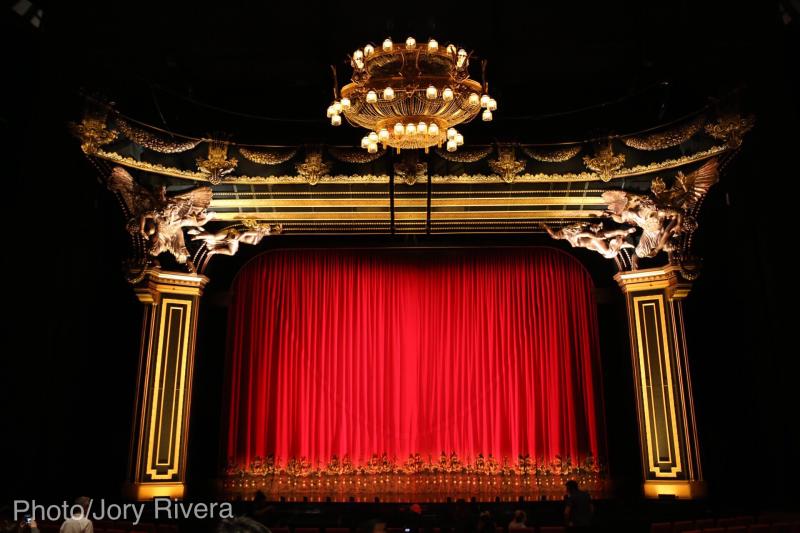 What I realized in this particular moment is that the Opera House is actually a microcosm of the Parisian society where elite theatre managers lord it over the small-time players, extras, and theatre crew, whose long, tedious hours of work are not properly compensated. Fast-track to the present times, this tiny world mirrors the great socio-economic divide prevalent in modern society, the Philippines in particular.
What I realized in this particular moment is that the Opera House is actually a microcosm of the Parisian society where elite theatre managers lord it over the small-time players, extras, and theatre crew, whose long, tedious hours of work are not properly compensated. Fast-track to the present times, this tiny world mirrors the great socio-economic divide prevalent in modern society, the Philippines in particular.
On another perspective, and rather obviously, the opera house hubbub is just but a parcel of a much bigger show--a love triangle in the tradition of Beauty and the Beast, and that all too familiar rivalry between an aging diva and a talented wannabe, Christine, who has been sidelined for lack of clout despite her genuine talent. Such an underdog story somehow has not lost its grip in this reviewer, or perhaps, in all of us whose romantic side has refused to die despite the stark realities of our modern world. Yes, the audience that night fell for it, once again, and much could be attributed to the aural-visual spectacles on full display, which overwhelmed our senses.
The Phantom's Lair
Under the Paris Opera House is the Phantom's lair--a disfigured man's hideaway from the cruel world of "normal, beautiful" humans. Here, the Phantom schemes his grand design of perennially possessing and torturing the Opera House and making the budding star Christine the lead role of his own musical obras. When, finally, the Phantom successfully abducts Christine, he brings her to his lair--a labyrinth of underground canals beautifully designed and recreated onstage in this touring production.
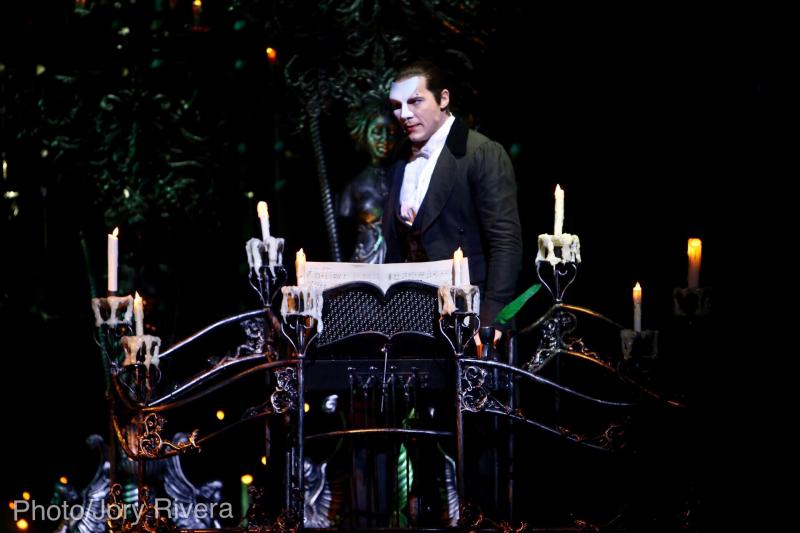 The height, breadth, and depth of the undergrounds, given the spatial limitations of the theatre, were obviously a huge challenge for the touring production and its local stagers. Onstage, the gondola ride seems short and abrupt, but the thrill of such abduction from the audience's point of view is still worth the great reckoning. Thanks to the masterful lighting and shadow projection, the Phantom and Christine's journey is still a thrilling sight to behold. And talking about masterful lighting, bookmark Christine's dressing room scene prior to her abduction--it squeals Rembrandt!
The height, breadth, and depth of the undergrounds, given the spatial limitations of the theatre, were obviously a huge challenge for the touring production and its local stagers. Onstage, the gondola ride seems short and abrupt, but the thrill of such abduction from the audience's point of view is still worth the great reckoning. Thanks to the masterful lighting and shadow projection, the Phantom and Christine's journey is still a thrilling sight to behold. And talking about masterful lighting, bookmark Christine's dressing room scene prior to her abduction--it squeals Rembrandt!
The Masquerade Ball
"Masquerade, paper faces on parade!"
That memorable line is synonymous with yet another thunderous visual and auditory spectacle, this time by the staircase. A showcase of colorful masks and costumes, which the local producers wanted to recreate at the Solaire lobby earlier, it heralds the second act. This scene was meant to be a New Year celebration and was expected to leave an impact in the audience's memory. At least that's how I anticipated it.
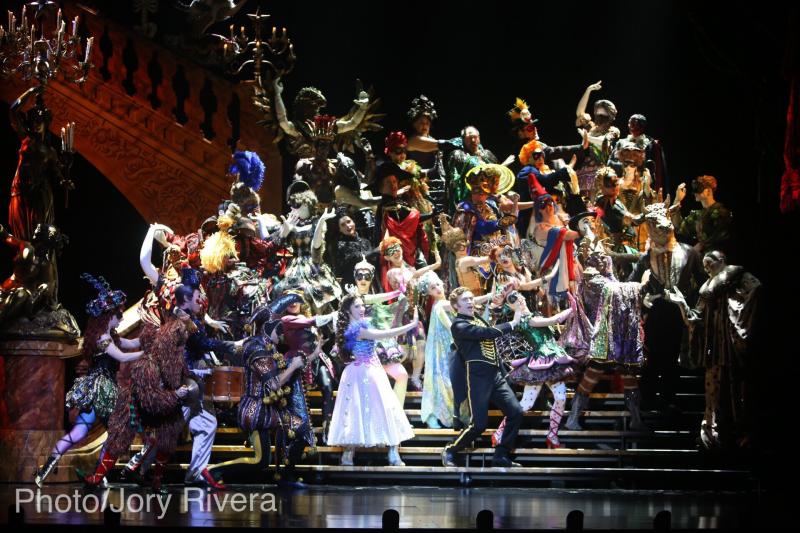 However, the gala night saw this scene lacking in choreographed disarray. It was obvious that actors were still adjusting to the limitations of the stage, their movements almost mechanical and uninspired. Not even the beautiful lighting could salvage the scene from falling flat and unexciting. This scene, I strongly think, needs to be reworked and refined. It does, however, leave that memorable line playing quite loudly and beautifully in my head:
However, the gala night saw this scene lacking in choreographed disarray. It was obvious that actors were still adjusting to the limitations of the stage, their movements almost mechanical and uninspired. Not even the beautiful lighting could salvage the scene from falling flat and unexciting. This scene, I strongly think, needs to be reworked and refined. It does, however, leave that memorable line playing quite loudly and beautifully in my head:
"Masquerade, paper faces on parade!"
The Chandelier
For hardcore Phantom fanatics, it would be a disappointment that this touring production makes use of a different chandelier.
From the orchestra ground, the contraption actually looks like an unidentified flying object, nowhere near its West End and Broadway prototype. And as if its unusual design weren't enough of a letdown, during that much-awaited moment, the chandelier crashes onto the stage with a---dud.
However, upon seeing promotional shots after the gala night, the chandelier actually looks beautiful and menacing from the balcony sections. Regardless of how anyone may have seen it, the scene lacks that important element--the crashing sound. Crashing sound or no crashing sound, this scene is still worth our curiosity and wait.
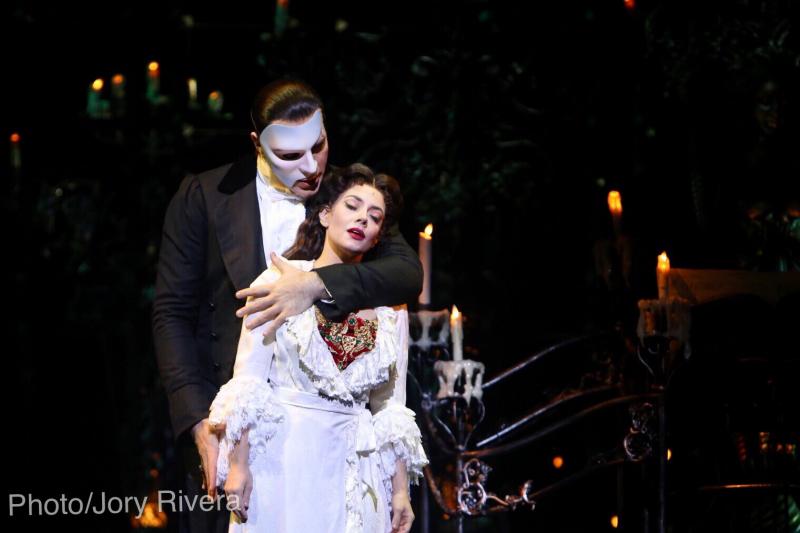 Roxmouth, Picerno, Leisy and Company
Roxmouth, Picerno, Leisy and Company
Jonathan Roxmouth (The Phantom), Meghan Picerno (Christine), and Matt Leisy (Raoul) all combined their vocal and acting forces to deliver a coup performance despite gala night jitters and/or adjustments.
Roxmouth is a voice to behold, soaring with each musical note, and dropping those big ones in The Music of the Night number with aplomb. His hand movements also reveal the other side of the character--the contortionist. His performance is mostly commendable, but he seemingly is unable to connect with the character and the audience at times. For instance, in the scene where his disfigured face is revealed by Christine, Roxmouth crawls in what seems to be an act of despair and piteousness. However, this fails to elicit audience empathy. His solo act before he brings down the chandelier also lacks the scary vibe. Despite such workable flaws, his graveyard scene with Christine and Raoul is literally and figuratively fiery and is one of the best moments of the show.
Picerno comes across mostly consistent. As Christine, she combines innocence and chutzpah quite successfully. Her duets with both Roxmouth and Leisy are all showstoppers; however, like Roxmouth, her performance was also marred by occasional underacting.
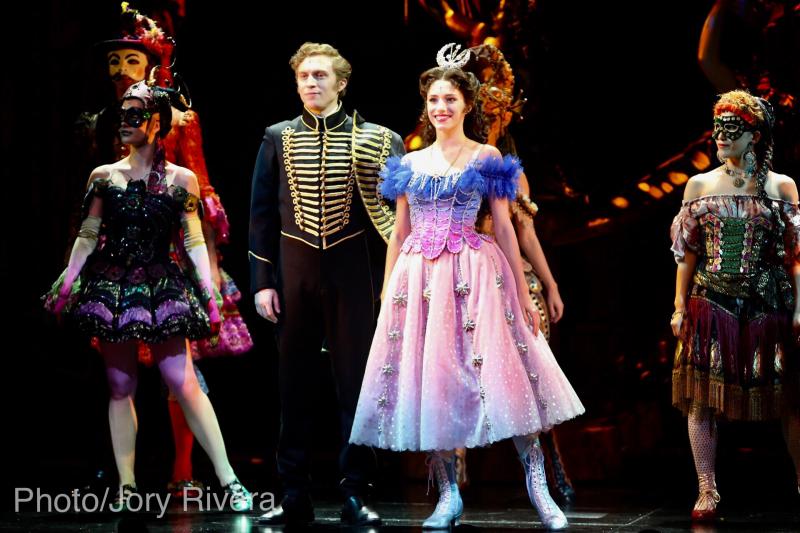 On the other hand, Leisy delivers a handsome and charming Raoul, but like Roxmouth and Picerno, also had weak moments. In his scene with them at the graveyard, he comes across the weakest. Perhaps one may want to look at his other role, Vicomte de Chagny, which he delivers rather so convincingly.
On the other hand, Leisy delivers a handsome and charming Raoul, but like Roxmouth and Picerno, also had weak moments. In his scene with them at the graveyard, he comes across the weakest. Perhaps one may want to look at his other role, Vicomte de Chagny, which he delivers rather so convincingly.
Key to the success of the show are its commendable ensemble players and supporting actors (James Borthwick, Curt Olds, Beverly Chiat, Melina Kalomas, Thabiso Masemene, Kiruna-Lind Devar), who navigated through the above-mentioned challenges and carried the show to a standing-O at the end.
The Verdict
Great musical theater, as genuine and regular patrons should know by now, is a formidable combination of great music (some melodies should haunt you the first time), good story (it doesn't have to be complicated but must have the smooth twists, right turns, and clear narrative), good direction, choreography (movements must help move the story forward), and of course, visual spectacle. Visual spectacle is what transcends time, allowing you to see those vivid images in what Wordsworth calls "that inward eye."
Mesmerizing and spectacular, The Phantom of the Opera is still a veritable force after three decades.
The Phantom of the Opera plays, on a extended run, now through April 6, 2019.
Get tickets from TicketWorld.com.ph.
Photos: Jory Rivera
Videos


